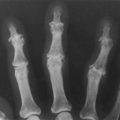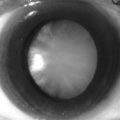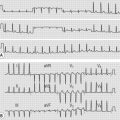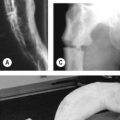146 Gynaecomastia
Salient features
Examination
• Palpate to confirm the presence of glandular tissue (before palpation ask the patient to lie flat on his back with his hands clasped beneath his head). Using the separated thumb and forefinger, slowly bring the fingers together from either side of the breast. In patients with true gynaecomastia, a rubbery or firm mound of tissue that is concentric with the nipple–areolar complex is felt, whereas in patients with pseudogynaecomastia, no such disk of tissue is felt.
• Tell the examiner that you would like to look for stigmata of cirrhosis.
Questions
Mention a few pathological causes
• Neoplasms (bronchogenic carcinoma, testicular carcinoma, hepatoma)
• Bulbospinal muscular atrophy or Kennedy syndrome (a defect in the androgen receptor alters function of motor neurons; 50% of patients have gynaecomastia)
Advanced-level questions
How would you investigate such a patient?
• Chest radiography for metastatic or bronchogenic carcinoma
• Plasma β-human chorionic gonadotrophin: detectable levels implicate a testicular tumour or lung or liver neoplasm
• Plasma testosterone and luteinizing hormone in the diagnosis of hypogonadism
• Serum oestradiol (usually normal)
• Other: serum prolactin, serum thyroxine and thyroid-stimulating hormone, and chromosomal analysis for Klinefelter syndrome.
What are the causes of a feminizing state?
• absolute increase in oestrogen formation by tumours
• increased availability of oestrogen precusors, e.g. as a result of cirrhosis
• increased extraglandular oestrogen synthesis
• relative increase in ratio of oestrogen to androgen, e.g. as a result of testicular failure
• drugs (estradiol and estrone, displaced by some drugs, resulting in an increase in free oestrogen).
How would you manage the patient?
• Acute florid stage of gynaecomastia: tamoxifen, 20 mg/day for up to 3 months, may be useful.
• When gynaecomastia has not regressed by 1 year or in patients who present with long-standing gynaecomastia who are troubled by their appearance, surgical removal of the breast glandular tissue and subareolar fat can be done for cosmetic reasons.
• Asymptomatic patients not bothered by the gynaecomastia without a suggestive history or physical examination, a more minimalist evaluation (i.e. measurements of testosterone and luteinizing hormone levels, although even the use of these tests may not be warranted): weight reduction.







